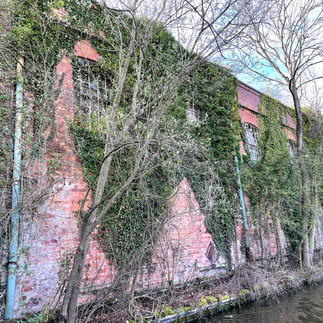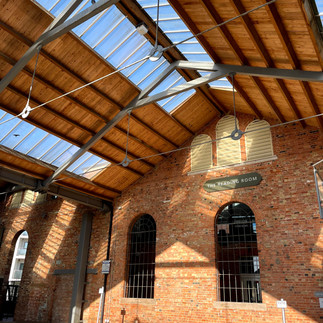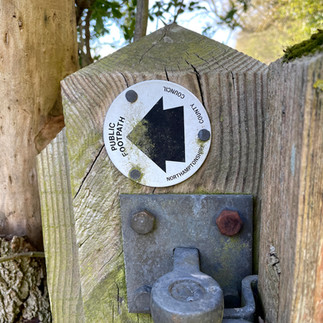Dear Motley Crew,
In retrospect, our decision to forego the rush to London for a slower, more in-depth, and considered journey had been the correct one. We had missed so much on our dash along the canal and were determined to make up for this on the return leg. The Iceberg Watch Officers' advice to “see a lot of a little rather than a little of a lot” had been noted and this dictum would now guide our future roamings.

We paused for a few days on a mooring with amazing views across to the Ivinghoe Beacon and used this time to explore the village of Ivinghoe and its surroundings. It has a church that dates from 1241,

and Tudor buildings, that date from, well, from the Tudor period,

but we were on the trail of something far more curious. We wended our way down small lanes and across paddocks, and suddenly, there it was.

Standing commandingly in splendid isolation in the middle of a crop of oats, was the Pitstone windmill. Built in the late16th century, and in continuous use until battered by a severe storm in the early 20th century, it is said to be one of Britain’s earliest examples of a post mill.

In contrast to later windmill designs, here, the entire mill is turned to catch the wind, by means of a beam and a wheel. I’m assuming that the job was undertaken by horses rather than slaves.

Although no longer in use, it seems that all internal mechanisms are still in place
We were finding, that, in common with so many other canals, the war had left its mark on the Grand Union canal as well. In Leighton Buzzard, which was now tantalisingly appearing and disappearing ahead of us, we would again be sleuthing, this time for a much smaller, probably mostly un-noticed feature marking the town’s association with the production of the Vickers Vimy bomber.

Named after the Battle of Vimy, these aircraft were manufactured by Morgan and Co., in an engineering works that once stood alongside the canal. Only a handful of the bombers ever saw service during WWI – their principal claim to fame was as long-distance record breakers during the inter-war period. In June 1919, the Vimy featured in the first non-stop crossing of the Atlantic, and later in that same year, an Australian crew completed a flight from the UK to Australia.

Successful sleuthing! Perched atop the clock tower on the local Tesco supermarket, which occupies the site of the original factory, is a weather-vane sporting a miniature model of a Vickers Vimy.
If Leighton Buzzard's wartime activities were in full, public view, Fenny Stratford’s activities during the same period were, by contrast, of a more covert and clandestine nature. On the outskirts of this innocuous town, sits Bletchley Park, a country house that became the principal base of the Allied code-breaking activities during WW2. It was here that Alan Turing, as part of a team of cryptologists, succeeded in deciphering the Enigma code, the method used by the German military forces for sending encrypted messages.

I wonder if, during his time at Bletchley, Turing’s mathematical deliberations were ever momentarily interrupted by the sound of a series of far-off explosions. Perhaps reasoning that it was war-related he may have turned back to his calculations without further consideration, not realising that what he had in fact heard was The Fenny Poppers. Each year since the mid-1700’s, these six, tankard-shaped cannons have been fired on the 11th of November, to commemorate the generous contributions made to the local church by one Browne Willis.

Sadly - due to Covid closures - we were unable to view the Poppers which are on permanent display in the church
It is true to say that almost over-whelming, each town or village that we have explored thus far on our travels, has had its share of thatched cottages, and a history stretching back hundreds of years. The town of Milton Keynes, however, is a break from this tradition. Conceived in the 60’s and designed to relieve the housing pressure in London, this large, modern community, is quite unlike most people's ideas of an English town. Amalgamated from15 smaller villages and planned on a grid pattern, it seems that it is either loved or hated with equal passion. It was once described as “the utterly de-personalised nightmare which haunted Aldous Huxley”, but we loved it. It has 6,000 acres of parklands, with an impressive network of connecting bikeways and public footpaths.
There are outdoor theatres,

and first-class cricket pitches.

It has lakes,

a labyrinth,

and a peace pagoda.

Quite oddly, it felt rather like a breath of fresh air.
As we left this Brave New World of 21st-century living, we became aware that Matanuska was being paced along the towpath, by, well, “something”. We caught fleeting glimpses of an antenna and could hear a faint, whirring sound, but we were left to speculate as to its identity, as “the thing” suddenly flashed out of sight down a side road. The mystery was solved a day or two later when we spotted another "thing" in the next village.
Okay - so what is it?
I wonder if you could get one of these as a pet?
Approaching Wolverton by canal affords visitors a very strong clue to the town's past and present industry base.

In the mid-1800's, the Wolverton Works was established here to produce and repair locomotives for the London and Birmingham Railway. Over the years, a decline in railway traffic meant that several of the workshops were closed down and then abandoned, and there had been talk that they would fall prey to the wrecker's ball. A stay of execution, however, has meant that many of the buildings will be retained and are now being incorporated into a new housing development and shopping precinct.
That's all very well, I hear the committed trainspotters among you intoning, but tell 'em the best train fact about Wolverton. Well, the best train fact is, of course, that the railway workshops in Wolverton were responsible for having built the Royal Train, and, to this day, it is still housed there.

We were now not too far from Blisworth and our second jabs, but I had learned that there was a dovecote to be found in the deserted medieval village of Furtho, and this was too great an enticement to ignore. So we moored up once again at Grafton Regis, and set off.
Public footpaths indicated the way through private yards, and across farmer's paddocks,
and led us surely to our destination.

Although I have seen many dovecotes, both here and in France, this was the first one to which I had been able to gain access.

It is thought that up to 550 nesting pairs of doves would have been housed inside here. Can you imagine the noise … and the smell?

The mystery of how the dove keeper gained access to the nests rested with, or on, this stump. This central block would have supported a revolving ladder, a potence, that allowed the dove keeper access to all the nests.

Simple and elegant.
And so, dear Motley Crew; one more run through the Stoke Bruene locks - one more run through Blisworth tunnel, and then our penultimate stay at Blisworth Marina.
We had been along this section of the canal so many times now, that even the sheep were beginning to recognise us.

The Captain, The Commodore, and The Cat













Commentaires